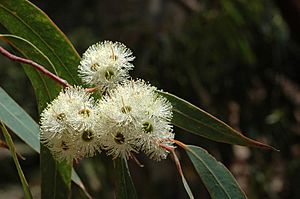Needlebark stringybark facts for kids
Quick facts for kids Needlebark stringybark |
|
|---|---|
 |
|
| Flowers of Eucalyptus planchoniana in the Australian National Botanic Gardens | |
| Scientific classification | |
| Genus: |
Eucalyptus
|
| Species: |
planchoniana
|
The Eucalyptus planchoniana, often called the needlebark stringybark or bastard tallowwood, is a special kind of tree. It is found only in eastern Australia. This tree has rough, stringy bark on its trunk and bigger branches. It also has long, curved leaves, white flowers, and fruit shaped like a cup or barrel.
What Does This Tree Look Like?
The Needlebark Stringybark usually grows to be about 20 to 25 meters tall. It has a special woody swelling at its base called a lignotuber. This helps the tree regrow after a fire.
Its bark is rough, reddish, and often feels a bit prickly. You'll find this stringy bark on the main trunk and larger branches.
Young plants and new shoots (called coppice regrowth) have bluish-green leaves. These leaves are shaped like an oval or a spear. They are about 7 to 20 centimeters long and 2.3 to 7 centimeters wide. These leaves also have a stalk, which is called a petiole.
The leaves on older trees are the same bluish-green color on both sides. They are shaped like a spear or are slightly curved. These adult leaves are much longer, about 8 to 26 centimeters long and 1.5 to 3.5 centimeters wide. Their stalks are about 1.5 to 3.2 centimeters long.
The tree's flower buds grow in groups of seven. They appear where the leaves join the stem, which is called a leaf axil. Each group of buds grows on a flat stem called a peduncle, which is about 2 to 3.2 centimeters wide. Each individual flower bud has its own small stalk, called a pedicel, also about 2 to 3.2 centimeters long.
When the buds are ready to open, they are oval or diamond-shaped. They are about 2 to 2.9 centimeters long and 0.8 to 1 centimeter wide. Each bud has a cap, called an operculum, which can be cone-shaped or pointed.
This tree blooms with white flowers from October to December. After the flowers, the tree produces woody fruit. These fruits are shaped like a cup, cylinder, or barrel. They are about 1.7 to 2.8 centimeters long and 1.6 to 2.6 centimeters wide. The parts that open to release seeds are below the rim of the fruit.
How It Got Its Name
The Eucalyptus planchoniana was first officially described in 1878. A famous botanist named Ferdinand von Mueller wrote about it in his book Fragmenta phytographiae Australiae. He used plant samples collected near Moreton Bay by Frederick Manson Bailey.
The second part of its scientific name, planchoniana, was chosen to honor Jules Emile Planchon. He was another important botanist.
Where Does It Grow?
The Needlebark Stringybark grows in open forests. You can find it on low ridges and gentle slopes. Its home stretches from Moreton Island and Stradbroke Island in Queensland, down to Camden Haven along the coast of New South Wales. It can also be found further inland, as far as the Gibraltar Range National Park.

